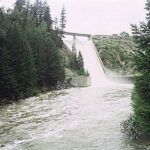
All of DNRC’s water projects support irrigated agriculture. Painted Rocks Dam, located on the West Fork of the Bitterroot River south of Darby, plays a vital role in sustaining the multi-million-dollar fishery of the Bitterroot River.
By the mid 1970s, irrigation demands on the Bitterroot River left it seriously dewatered during some summers. The stretch of river between the towns of Hamilton and Florence was most severely affected, says Chris Clancy, Regional Fisheries Biologist for the Montana Department of Fish, Wildlife & Parks (FWP).
“In low water years, there wasn’t much water left in the river between Tucker and Stevensville,” Clancy says. “The Bitterroot is heavily used by irrigators and in late summer during dry years you could walk across the main channel and not get very wet.”
Local sportsmen and FWP began to explore the possibility of using stored water out of Painted Rocks Reservoir to supplement flows on the Bitterroot. “Fish, Wildlife and Parks in 1958 had a contract with DNRC for 5,000 acre-feet of water,” says Larry Schock, Regional Engineer at DNRC’s Water Resources Office in Missoula. “In 1992, they contracted for an additional 10,000 acre-feet.”
FWP’s 15,000 acre-feet of water accounts for nearly half of Painted Rocks’ 32,000 acre-feet storage capacity. The management plan calls for holding onto that stored water until stream flows on the Bitterroot diminish to a target level. Water is then released at a rate biologists deem necessary to safeguard the fish population through the hottest, driest weeks of late summer and early fall.
As part of the operating agreement, FWP also agreed to pay the salary of a water commissioner.
“His job was to shepherd the water down the river and make sure everyone was taking their allocated amount, and to make sure FWP water stayed in the river,” says Clancy. “He had a lot of credibility and gained people’s trust. Over time, the irrigators, water commissioner, DNRC and FWP evolved a unique system. People started to recognize and understand each other’s water uses and needs.
“Today, people on the Bitterroot cooperate more for water management than on most rivers in the state. It’s not perfect, but we actually have a situation where irrigators voluntarily don’t take all the water they’re entitled to—they’ll leave it in stream to benefit fisheries and recreation.”
2013, a very low water year, offers a prime example. After reviewing the numbers, Clancy says irrigators used approximately two-thirds of the water they were legally entitled to, leaving the rest in the river.
Each year, FWP calls on DNRC to begin releasing its water in mid-July. The goal of the releases is to maintain a minimum flow of 400 cubic feet per second (cfs) at Bell Crossing on the Bitterroot. “That’s the area we monitor to see how we’re doing,” Clancy says. “We don’t always hit 400 cfs. In a really dry year we hope for 200 cfs. We coordinate with the water commissioner and decide exactly when we’ll start releasing. The commissioner keeps track of how much water we’ve used and how much we have left.” Flows typically continue through mid-September.
Larry Schock has been part of DNRC’s management team for Painted Rocks since 1995. “Painted Rocks is the lifeblood of the Bitterroot River, and that’s never more apparent than during a really dry year like we had in 2013,” he says. “The coordination between DNRC and Fish, Wildlife and Parks makes it possible to have sustained flows on the river when they’re most needed.”
The Bitterroot River is one of the most heavily-fished rivers in the state and the most-fished river west of the Continental Divide. It typically attracts more than 100,000 angler-days of use each year, according to FWP surveys. In 2009, the total was 110,000 angler-days. In its upper reaches, the Bitterroot supports about 1,000 trout per mile, including a healthy population of cutthroat trout; in the lower reaches, the fishery is dominated by rainbow and brown trout, with populations of 500 to 600 trout per mile.
The Bitterroot River and its fishery are a source of income for guides, outfitters, fly shops, restaurants and lodging establishments up and down the valley. Victor resident Jack Mauer has operated Wapiti Waters, a guiding and outfitting business, for nearly 40 years. He spends at least 100 days a year on the Bitterroot guiding clients, and understands the value of in-stream flows as well as anyone.
“Without Painted Rocks, FWP and the other people who care about this river, we’d be in a world of hurt,” says Mauer. “We’ve got conscientious irrigators. We’ve got the in-stream flows to work with. There’s cooperation and it’s a great thing.”
–Information courtesy of DNRC.
